| |||||
| Decades: | |||||
|---|---|---|---|---|---|
| See also: | Other events of 1872 Years in Iran | ||||
The following lists events that have happened in 1872 in Iran.
| |||||
| Decades: | |||||
|---|---|---|---|---|---|
| See also: | Other events of 1872 Years in Iran | ||||
The following lists events that have happened in 1872 in Iran.
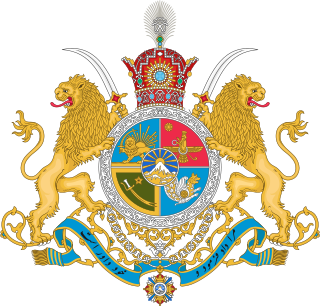
The Pahlavi dynasty was the last Iranian royal dynasty that ruled for almost 54 years between 1925 and 1979. The dynasty was founded by Reza Shah Pahlavi, a non-aristocratic Mazanderani soldier in modern times, who took on the name of the Pahlavi language spoken in the pre-Islamic Sasanian Empire to strengthen his nationalist credentials.
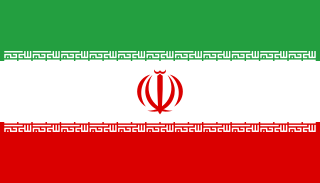
The national flag of the Islamic Republic of Iran, also known as the tricolour, is a tricolour featuring the Pan-Iranian colors comprising equal horizontal bands of green, white and red with the national emblem ("Allah") in red centred on the white band and the takbir written 11 times each in the Kufic script in white, at the bottom of the green and the top of the red band. After the Iranian Revolution of 1979, the present-day flag was adopted on 29 July 1980.

The Qajar dynasty was an Iranian dynasty founded by Mohammad Khan of the Qoyunlu clan of the Turkoman Qajar tribe.

Mohammad Ali Shah Qajar was the sixth shah of the Qajar dynasty and remained the Shah of Iran from 8 January 1907 until being deposed on 16 July 1909.

Fath-Ali Shah Qajar was the second Shah (king) of Qajar Iran. He reigned from 17 June 1797 until his death on 24 October 1834. His reign saw the irrevocable ceding of Iran's northern territories in the Caucasus, comprising what is nowadays Georgia, Dagestan, Azerbaijan, and Armenia, to the Russian Empire following the Russo-Persian Wars of 1804–1813 and 1826–1828 and the resulting treaties of Gulistan and Turkmenchay. Historian Joseph M. Upton says that he "is famous among Iranians for three things: his exceptionally long beard, his wasp-like waist, and his progeny."

Mozaffar ad-Din Shah Qajar, was the fifth Qajar shah (king) of Iran, reigning from 1896 until his death in 1907. He is often credited with the creation of the Persian Constitution of 1906, which he approved of as one of his final actions as shah.
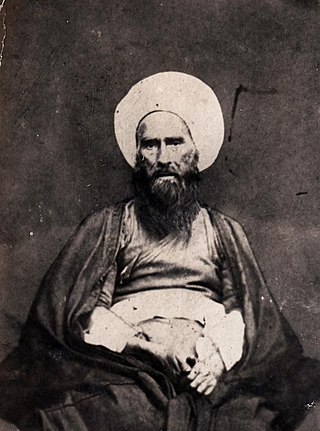
Hadi Sabzavari or Hajj Molla Hadi Sabzavari was an Iranian philosopher, mystic theologian and poet.

Qajar art was the architecture, paintings, and other art forms produced under the Qajar dynasty, which lasted from 1781 to 1925 in Iran (Persia).

The Shrine of Fatima Masumeh is located in Qom, which is considered by Twelver Shia Muslims to be the second most sacred city in Iran after Mashhad.

The Russo-Persian War of 1826–1828 was the last major military conflict between the Russian Empire and Qajar Iran, which was fought over territorial disputes in the South Caucasus region.
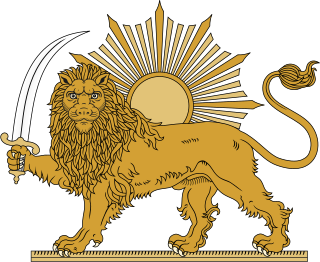
The Lion and Sun is one of the main emblems of Iran (Persia), and was an element in Iran's national flag until the 1979 revolution and is still commonly used by nationalists and opposition groups of the Islamic Republic government. The motif, which illustrates ancient and modern Iranian traditions, became a popular symbol in Iran in the 12th century. The lion and sun symbol is based largely on astronomical and astrological configurations: the ancient sign of the sun in the house of Leo, which itself is traced back to Babylonian astrology and Near Eastern traditions.

The Persian Constitutional Revolution, also known as the Constitutional Revolution of Iran, took place between 1905 and 1911 during the Qajar dynasty. The revolution led to the establishment of a parliament in Persia (Iran), and has been called an "epoch-making episode in the modern history of Persia".
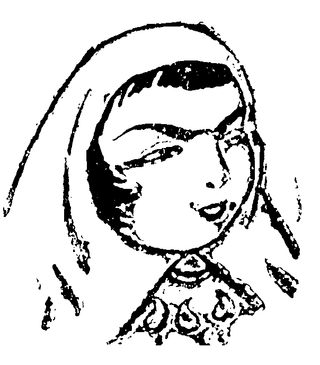
Agha Baji Javanshir was an Iranian poet and public speaker, who was the twelfth wife of Fath-Ali Shah Qajar, the Qajar shah (king) of Iran. She was the daughter of Ibrahim Khalil Khan, the governor of the Karabakh Khanate.

The Imperial State of Iran, officially the Imperial State of Persia until 1935, and commonly referred to as Pahlavi Iran, was the Iranian state under the rule of the Pahlavi dynasty. The Pahlavi dynasty was created in 1925 and lasted until 1979, when it was ousted as part of the Islamic Revolution, which ended Iran's continuous monarchy and established the current Islamic Republic of Iran.

The Guarded Domains of Iran, commonly called Qajar Iran, Qajar Persia or the Qajar Empire, was the Iranian state under the rule of the Qajar dynasty, which was of Turkic origin, specifically from the Qajar tribe, from 1789 to 1925. The Qajar family took full control of Iran in 1794, deposing Lotf 'Ali Khan, the last Shah of the Zand dynasty, and re-asserted Iranian sovereignty over large parts of the Caucasus. In 1796, Agha Mohammad Khan Qajar seized Mashhad with ease, putting an end to the Afsharid dynasty. He was formally crowned as Shah after his punitive campaign against Iran's Georgian subjects.
The following lists events that have happened in 1925 in the Qajar dynasty.
The following lists events that have happened in 1908 in the Qajar dynasty in Iran.

The Shah Mosque, also known as the Soltāni Mosque meaning "royal", renamed the Imam Mosque, after the 1979 Iranian Revolution, is a principal mosque in the northern section of the Grand Bazaar in Tehran, Iran.

The Sepahsālār Mosque is a famous historic mosque in Tehran, Iran. The construction project of the mosque was started in 1879 upon the order of Mirza Hosein Sepahsalar, the Grand Vizir of Iran during Naser al-Din Shah Qajar, and the first phase of construction was finished after five years since it was started. The mosque was renamed the Shahid Motahhari, after the 1979 Iranian Revolution, but it is commonly known as its initial name of Sepahsalar Mosque.
Mirza Mohammad Taqi Sepehr, also known as Mirza Mohammad Taqi Kashani, or with the honorific Lesan ol-Molk, was an Iranian court historian and littérateur of the Qajar era. He wrote with the pen name Sepehr, and is known for authoring the lengthy Persian chronicle Nasekh ol-tavarikh-e salatin-e Qajariyeh, also simply known as the Nasekh ol-tavarikh.